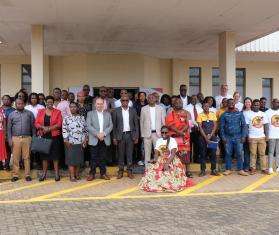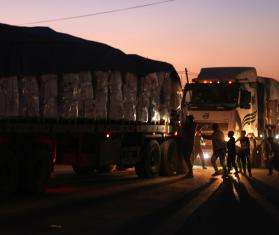Doctors Without Borders/Médecins Sans Frontières (MSF) has opened a new maternity unit for pregnant women with Ebola—or those suspected of having Ebola—within an Ebola treatment center in Sierra Leone.
The new maternity unit is in Kissy, a suburb of Freetown, where MSF has been working since January 8, 2015. The center has been admitting patients for the past three weeks, but the new maternity unit for suspected and confirmed Ebola patients will enable medical teams to provide specialized care for pregnant women.
Relatively little is known about Ebola and pregnancy, so the opening of the maternity unit will bring about increased understanding of the effects of Ebola on this vulnerable group and the potential benefits of obstetric care for infected women. Here, MSF midwife Ruth Kauffmann discusses how MSF is proving that pregnant women can survive the disease.
“Before this outbreak, all we really knew about pregnancy and Ebola was that usually the women die either while pregnant or else during the birth. As Ebola is a hemorrhagic fever, once a woman goes into labor, she will most likely bleed to death.
We also knew that unborn babies don’t survive, as the virus appears to concentrate itself in the placenta and in the amniotic fluid which surrounds the fetus.
As the number of people infected in other outbreaks was low—too low to gain an understanding of how Ebola impacted pregnancy—little research had been done.
But as we’re seeing so many more people infected with the disease in this outbreak, we are learning a lot more about Ebola.
READ: PREGNANT WITH EBOLA, A SURVIVOR'S TALE
We were surprised that two pregnant women at MSF’s center in Guéckédou, Guinea, and two more across the border in Foya, Liberia, had managed to recover from Ebola, give birth, and survive.
Once a woman is better, it seems that the best thing for her to do is birth the fetus, as it has become a ball of concentrated virus in her body. So we began to look at how to do this in a controlled way that is safe for the people assisting the birth and that will ultimately help the woman survive.
I was working as a midwife at an MSF-run community health center in Bo, Sierra Leone, when I got a call from our Ebola management center in Kailahun, in the remote northwest of the country. They said they had one pregnant woman who had almost recovered from Ebola, and asked if I could come and help with the birth. Almost immediately a second pregnant woman was admitted to the same center. I packed my bags and got a lift up to Kailahun.
There I met Kumba, who was seven months pregnant with her third child. She had arrived at the center with a high viral load, and had been there for about a month.
Kumba knew that her baby was going to be born dead; she had felt no movement for some time.
We wanted to induce Kumba’s labor in as controlled a way as possible. We didn’t want her to go into labor in the middle of the tent. Not only would it be undignified for her, but if there was a lot of infected blood and amniotic fluid around, then it would be risky for everyone.
Kenema hospital, in central Sierra Leone, lost a number of its nurses to Ebola after they attended the birth of an Ebola-positive colleague. Strict infection control is vital.
We needed a place that would be clean and afford some protection—both for Kumba and for those attending her. Luckily, the team had just finished constructing a small building for people who needed extra privacy, so we were able to use it for the birth.
We were wearing the standard protective clothing for Ebola, but with extra-long gynecological gloves on top of the three other layers of gloves. When you are attending a birth, you move around a lot and you really need to make sure that your mask doesn’t slip and that your headgear doesn’t ride up.
You can’t stay inside the high-risk zone, in all your protective gear, for more than an hour at a time. So you also need someone on standby who can come in to relieve you. We had two nurses waiting outside who, even though they didn’t have much experience [with] birth, were able to monitor Kumba’s vital signs and reassure her.
Before inducing labor, we gave Kumba antibiotics, on the assumption that she would have an infection from carrying around a dead fetus for some time. We also assumed that she would bleed during labor, so we had a lot of anti-hemorrhagic medication ready for after the birth.
Kumba’s labor took about a day and a half, and it went as well as we could have hoped. With Ebola, you don’t want to touch the baby and you don’t want to pull the placenta out; you leave all of that to happen on its own.
What was really amazing about this birth was that, by the next morning, Kumba was stable. She wasn’t bleeding much, and we were able to take out the IVs and the catheter.
The other pregnant woman at the center was Musa. She had arrived with her two-year-old child, who also had Ebola, and both were now on the way to recovery.
We told Musa that we weren’t going to be able to help her with the birth too much, and she would need to do it herself. This was hard, but with limited time inside the high-risk zone, you have to decide when you’re going to be most useful.
The biggest risk for the mother is right after the birth. If you’re in there for 30 minutes of pushing time, then you don’t have a lot of time or energy left for the next stage: making sure the placenta comes out properly and that [the mother] doesn’t bleed.
The birth went really well and within a couple of hours Musa was ready to get up.
Birth is so special, even in these circumstances. Whatever the culture, you are immediately intimate with the woman. To be a part of this intimacy is so rewarding—and even more so in the context of Ebola.
Kumba and Musa’s experiences really confirmed to me that, with the resources and with specialized care, pregnant women can be helped to survive Ebola. We may not be able to save the lives of their unborn children, but we can save theirs. In all of my years with MSF, this has been the hardest but also the best thing that I have done.”
Sierra Leone has one of the highest maternal mortality rates in the world. The MSF maternity unit in Kissy has 33 beds for confirmed and suspected cases of Ebola, while the treatment center has another 40 beds, where some pregnant women were actually treated.





